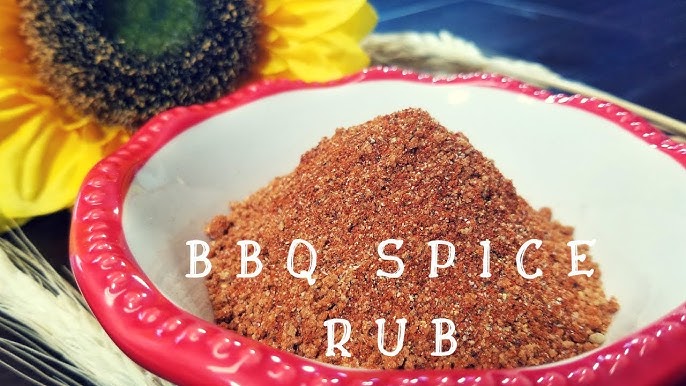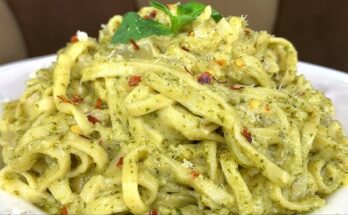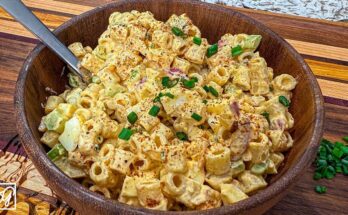BBQ Spice Rub Recipe: When it comes to grilling or smoking meat, nothing sets the tone like a killer BBQ spice rub. It’s that magical blend of spices that gives your meat a punch of flavor even before the sauce hits the grill.
Whether you’re cooking up ribs, brisket, chicken, or even vegetables, a good rub is the foundation of a mouthwatering BBQ experience.
Today, we’re diving deep into a finger-lickin’ BBQ spice rub recipe that’s not only easy to make but totally customizable.
Let’s get that smoke rolling!
What is a BBQ Spice Rub?
A BBQ spice rub is a dry mixture of spices and herbs that’s rubbed directly onto meat before cooking. Unlike marinades, rubs don’t contain liquids. Instead, they coat the meat, forming a flavorful crust when grilled or smoked. They can be sweet, spicy, smoky—or all three.
There are two primary types:
- Dry Rubs: These are made purely of dry spices and herbs. They’re ideal for a classic BBQ texture and can create that crusty bark on smoked meat.
- Wet Rubs: Add a bit of oil, vinegar, or mustard to a dry rub to create a paste-like consistency. This type is perfect for sticking to tricky meats like chicken wings.
Dry rubs are the go-to choice for pitmasters, and once you try your own homemade blend, you’ll never go back to store-bought.
Why Make Your Own BBQ Rub?
Sure, buying a pre-made rub is convenient, but it’s like buying a pre-made playlist—it might be okay, but it won’t be your jam. Here’s why crafting your own rub is a total game-changer:
- Flavor Customization: Love it spicy? Dial up the cayenne. Prefer it sweet? Add more brown sugar. Making your own rub lets you fine-tune the flavor profile to match your exact taste buds.
- Cost-Effectiveness: Store-bought rubs can be pricey. Creating your own not only saves money but also means no weird preservatives or additives.
- Versatility: Once you’ve nailed your signature rub, you can use it on everything—from pork and beef to tofu and veggies.
Creating a BBQ rub is part art, part science, and all deliciousness. Plus, you probably already have most of the ingredients sitting in your spice rack.
Essential Ingredients for a Classic BBQ Rub
A great BBQ rub balances sweet, savory, and spicy elements. Here’s the breakdown of what you’ll need:
Sweet Components:
- Brown Sugar: Adds sweetness and helps form that caramelized crust.
- White Sugar: Offers a sharper sweetness and blends well.
Savory Spices:
- Salt: Enhances all the other flavors—sea salt or kosher salt is ideal.
- Black Pepper: Adds depth and a slight heat.
- Paprika: Gives the rub a smoky, rich flavor. Smoked paprika takes it to another level.
- Garlic Powder & Onion Powder: These add complexity and umami.
Heat and Aromatics:
- Cayenne Pepper or Chili Powder: For that fiery kick.
- Mustard Powder: Adds tang and brightness.
- Cumin: Brings an earthy warmth that complements grilled meats.
Want to get fancy? Try adding crushed fennel seeds, ground coriander, or even instant espresso powder for a gourmet twist.
Tools You’ll Need for Mixing and Storing
Don’t worry—you won’t need any fancy gadgets. Just a few kitchen basics will do:
Measuring Tools:
- Measuring spoons for accuracy.
- A small mixing bowl or mason jar for combining the ingredients.
Storage Tips:
- Glass Jars: Airtight and preserves freshness. A mason jar or spice jar with a tight-fitting lid works perfectly.
- Label It: Always write the date and name of the rub. Trust us, you’ll forget otherwise!
- Keep It Cool: Store in a cool, dark cabinet away from direct sunlight and heat.
With proper storage, your rub can stay fresh for up to six months—if it lasts that long.
Step-by-Step Guide to Making the BBQ Rub
Let’s put it all together now. This step-by-step guide ensures you get a perfectly balanced rub every single time.
Step 1: Measure Your Ingredients
Here’s a basic recipe to get started:
- 1/2 cup brown sugar
- 1/4 cup paprika (smoked if possible)
- 1 tbsp black pepper
- 1 tbsp kosher salt
- 1 tbsp chili powder
- 1 tbsp garlic powder
- 1 tbsp onion powder
- 1 tsp cayenne pepper
- 1 tsp mustard powder
- 1/2 tsp cumin
Step 2: Blend the Spices
Pour all the measured spices into a bowl or jar. Stir or shake until everything is evenly mixed. Make sure there are no clumps—sifting the mix can help with this.
Step 3: Store it Properly
Transfer the rub into your airtight jar. Label it and stash it somewhere dark and dry. Boom—you’re now officially a spice mixologist.
Best Meats to Use with BBQ Rub
One of the best things about a good BBQ spice rub is its versatility. You can slap it on just about any meat, and it’ll work its magic. But some meats really shine when paired with the right rub. Here’s a breakdown of the best meats to use your homemade BBQ rub on:
Pork
Pork and BBQ rubs are like best friends at a cookout. The sweetness of brown sugar and the smokiness of paprika complement pork beautifully. Here are some pork cuts that really sing when rubbed:
- Pork Ribs: Baby backs or spare ribs both develop an irresistible bark.
- Pork Shoulder: Perfect for pulled pork—let the rub soak in overnight for max flavor.
- Pork Chops: Rubbed and grilled, they get a caramelized crust that’s simply mouthwatering.
Chicken
Chicken might seem plain, but it’s a blank canvas for flavor. BBQ rub adds depth and turns everyday chicken into a backyard hero.
- Whole Chicken or Drumsticks: Rub under the skin for a juicy flavor bomb.
- Wings: Toss in rub before grilling or baking. Finish with a dash of sauce if you want.
- Breasts: Perfect for meal prep, rub and grill for juicy, flavorful chicken that stores well.
Beef
For a bold, hearty flavor, beef is where it’s at. The richness of beef pairs well with spices like cumin, black pepper, and chili powder.
- Brisket: A BBQ legend. A heavy rub creates that classic smoked bark.
- Steaks: A quick dry rub before grilling enhances the natural flavors.
- Beef Ribs: Meaty and rich—great for slow smoking with a spice-heavy rub.
You can even experiment with lamb, turkey, or fish, just tweak the spice ratio to suit the meat. The key is balance—stronger meats can handle bolder spices, while milder ones need a gentler touch.
How to Apply BBQ Rub Like a Pro
Applying the rub isn’t just about sprinkling it on and calling it a day. There’s a method to the madness if you want that flavor to really pop. Here’s how to apply your BBQ rub like a seasoned grillmaster:
Tips for Rubbing
- Pat Meat Dry First: Moisture on the surface can make the rub slide off. Use paper towels to get it bone-dry.
- Use a Binder (Optional): Some people rub a thin layer of olive oil, mustard, or Worcestershire sauce on the meat before the rub. This helps the spices stick better.
- Generous but Even: Don’t skimp—coat it like you mean it. But make sure it’s even so you don’t end up with clumps.
- Massage It In: Gently press the rub into the meat. Don’t just sprinkle it—give it some love!
Rest Time
Let your rubbed meat rest before cooking. This lets the flavors penetrate and the salt begin to tenderize:
- Minimum: 15–30 minutes if you’re in a hurry.
- Ideal: 4–6 hours in the fridge.
- Best: Overnight for a deep, rich flavor.
Wrap it in plastic wrap or place it in a sealed container. When you’re ready to cook, let it come to room temp before hitting the grill or smoker.
Properly applying your rub can mean the difference between average and unforgettable BBQ.
BBQ Rub Variations to Try
Once you’ve mastered the base rub, it’s time to experiment! Here are a few flavor profiles you can explore by tweaking the ingredients:
Spicy Rub
For those who like to feel the heat:
- Increase the cayenne to 2 tsp
- Add 1 tsp crushed red pepper flakes
- Toss in 1 tsp chipotle powder for smoky heat
Sweet Rub
Perfect for pork or chicken:
- Up the brown sugar to 3/4 cup
- Add 1 tbsp ground cinnamon
- Try 1 tsp nutmeg for a warm, sweet aroma
Smoky Rub
Ideal for replicating that wood-smoked flavor on a gas grill:
- Use smoked paprika instead of regular
- Add 1 tsp ground coriander
- 1/2 tsp ground clove adds a deep, woody note
Feel free to make a small batch first to test it out. Write down your changes—your future self will thank you when you hit the jackpot!
How to Store Your BBQ Spice Rub
You’ve crafted the perfect BBQ spice rub, and now it’s time to keep it fresh and flavorful for your next cookout. Proper storage is key—if not done right, spices can lose their potency or even go bad. Here’s how to do it like a pro:
Shelf Life
Homemade BBQ rub, if stored correctly, can last anywhere from 6 to 12 months. However, for peak flavor, it’s best to use it within 4 to 6 months. The fresher the spices, the longer your rub will stay bold and aromatic.
Pro tip: Make small batches unless you’re grilling every weekend. It ensures you always have a fresh blend on hand without worrying about staleness.
Avoiding Clumping
Sugar-based rubs can sometimes clump up, especially in humid climates. Here’s how to avoid that:
- Use a Dry Spoon: Moisture is your rub’s enemy. Always scoop it out with a dry utensil.
- Add a Desiccant: You can place a food-safe moisture absorber (like a silica packet) in the jar.
- Add Rice Grains: Drop a few grains of uncooked rice wrapped in cheesecloth into the jar. It helps absorb moisture naturally.
Storage Containers
Glass jars are the best choice—they don’t absorb odors, are easy to clean, and preserve the rub’s aroma. Mason jars, spice containers with screw-on lids, or even old jelly jars work perfectly. Plastic containers can work too, but make sure they are airtight and BPA-free.
Storage Environment
Keep your rub in a cool, dry, and dark place. Avoid placing it near the stove, oven, or any area with frequent temperature changes. Direct sunlight can degrade the spices faster.
Label each batch with the date it was made and what variation it is (sweet, spicy, smoky, etc.). That way, you’re always using your freshest mix and can recreate your favorites easily.
Common Mistakes to Avoid
Even seasoned grillers can mess up their spice rubs. Here are the most common pitfalls to steer clear of:
1. Over-seasoning
Too much rub can overpower the meat. While a generous coating is essential, piling it on can lead to a crust that’s too salty or too spicy. Remember—balance is everything. You want the meat and the rub to complement each other, not compete.
2. Using Old Spices
The flavor in your rub is only as good as the spices you put into it. If you’re using spices that have been in your pantry for years, chances are they’ve lost their punch. Check your spice dates and give them a sniff test—if they don’t smell strong, they won’t taste strong either.
3. Improper Storage
We touched on this earlier, but it’s worth repeating—keep your rub dry and away from light and heat. A humid environment can ruin a perfectly good mix in days.
4. Applying the Rub Right Before Grilling
While you can apply a rub right before grilling, giving it time to rest on the meat helps the flavors penetrate. Even 30 minutes makes a big difference.
5. Not Adjusting for Salt Content
If your rub contains salt, and you’re using it on brined or salted meat, it can quickly become too salty. In those cases, either reduce the salt in the rub or skip salting the meat beforehand.
By avoiding these common mistakes, you’ll ensure your BBQ is always on point and bursting with flavor.
Making it Keto or Sugar-Free
Watching your carbs but still want to enjoy smoky, flavorful BBQ? Good news: you can easily make your rub keto-friendly or sugar-free with a few smart swaps.
Substitute Ingredients
- Brown Sugar Substitute: Use a keto-friendly sweetener like Swerve Brown, Monk Fruit, or Erythritol-based brown sugar substitutes. These mimic the taste and texture of real brown sugar without the carbs.
- Avoid High-Carb Spices: Be cautious with spice blends that include cornstarch or other fillers.
- Low-Sugar Add-Ons: If you’re adding sauce later, opt for sugar-free BBQ sauce or make your own.
Keto-Friendly BBQ Rub Recipe Example:
- 1/4 cup keto brown sugar substitute
- 2 tbsp smoked paprika
- 1 tbsp garlic powder
- 1 tbsp onion powder
- 1 tbsp chili powder
- 1 tbsp sea salt
- 1 tsp cumin
- 1/2 tsp cayenne pepper (optional for heat)
- 1/2 tsp black pepper
This version keeps it low-carb without sacrificing flavor. It’s especially great for keto pulled pork or grilled chicken thighs.
Keto doesn’t mean flavorless. With the right ingredients, you can still bring the heat, the smoke, and the mouthwatering taste to your table.
BBQ Rub vs Marinade
BBQ spice rubs and marinades often serve the same purpose—flavoring your meat—but they work in entirely different ways. Understanding the difference between the two can help you choose the right method depending on your cooking style, time, and taste preference.
BBQ Rub: A Dry Punch of Flavor
A spice rub is typically dry (though wet rubs exist) and made of a mix of herbs, spices, and seasonings. It’s massaged directly onto the surface of the meat to form a crust that locks in moisture and boosts flavor during cooking.
Pros:
- Creates a flavorful bark (especially in smoked meats)
- No need for long marination time
- Easy to store and prepare
- Intensifies flavor on the outer layer
Cons:
- Doesn’t penetrate as deeply into the meat
- Can become too salty if not balanced
Marinade: A Deep-Flavor Soak
A marinade is a liquid mixture that often includes acid (like vinegar, citrus, or wine), oil, and seasonings. It’s used to tenderize meat and infuse flavor throughout by letting the meat soak for hours or even overnight.
Pros:
- Deeply flavors the meat inside and out
- Can tenderize tougher cuts
- Great for thin cuts and skewers
Cons:
- Takes more time
- Can be messy
- Too much acid can make meat mushy
Quick Tip: For the best of both worlds, you can use a marinade first, then dry the meat and apply a rub before cooking. This combo brings layered flavor to your dish that’s hard to beat.
Perfect Side Dishes for BBQ Rubbed Meats
No BBQ feast is complete without some killer side dishes to round out the meal. Whether you’re going for classic comfort or a modern twist, here are some favorites that pair perfectly with BBQ rubbed meats:
Classic Coleslaw
A cool, crunchy counterbalance to the smoky spice of BBQ. Opt for a vinegar-based slaw for a lighter bite or creamy mayo-style for something richer.
Cornbread
Slightly sweet, fluffy, and perfect for mopping up juices. Add a dash of jalapeño or shredded cheddar for an extra punch.
Baked Beans
Sweet, savory, and smoky, baked beans are a BBQ staple. Add some diced bacon or brisket to elevate the flavor.
Grilled Corn on the Cob
Brush with butter and sprinkle with salt, or go wild with a chili-lime crema and cotija cheese.
Potato Salad
Creamy or mustard-based, this crowd-pleaser adds comfort to any BBQ plate.
Pickles and Pickled Veggies
Their sharpness cuts through the richness of the meat and resets your taste buds between bites.
Pro BBQ Platter Tip: Pair your meat with a mix of textures—something creamy, something crunchy, and something sweet or tangy.
FAQs about BBQ Spice Rub Recipe
1. How long should I let the rub sit on the meat before cooking?
Ideally, let it sit for at least 30 minutes, but overnight is best for deeper flavor.
2. Can I use BBQ rub on vegetables?
Absolutely! Sprinkle it on grilled corn, roasted potatoes, or even grilled tofu for an extra kick.
3. What’s the difference between smoked and regular paprika in a rub?
Smoked paprika adds a deeper, more intense flavor that mimics the taste of slow-cooked wood smoke.
4. How can I tell if my BBQ rub has gone bad?
If it’s lost its aroma or smells musty, or if it’s clumping excessively, it’s time to make a fresh batch.
5. Can I make a salt-free version of BBQ rub?
Yes, just skip the salt and let users add salt to taste during or after cooking.
Conclusion
Creating your own BBQ spice rub is more than just mixing a few spices—it’s about building a foundation of flavor that defines your grilling game. From understanding what makes a great rub to storing it like a pro and knowing how to apply it, you’re now equipped to turn any cut of meat into a masterpiece.
Whether you’re a backyard BBQ enthusiast or a weekend warrior with a smoker, this guide gives you all the tools to bring serious flavor to your plate. The best part? Once you’ve got your signature rub down, it becomes part of your identity as a grillmaster.
So grab your spices, get that meat ready, and fire up the grill. Your next BBQ could be your best one yet.



